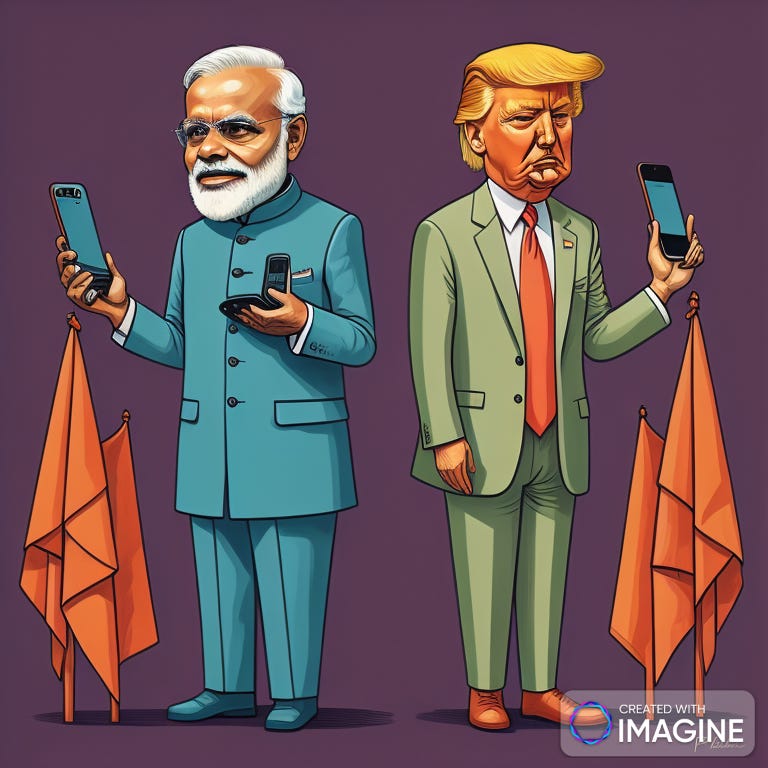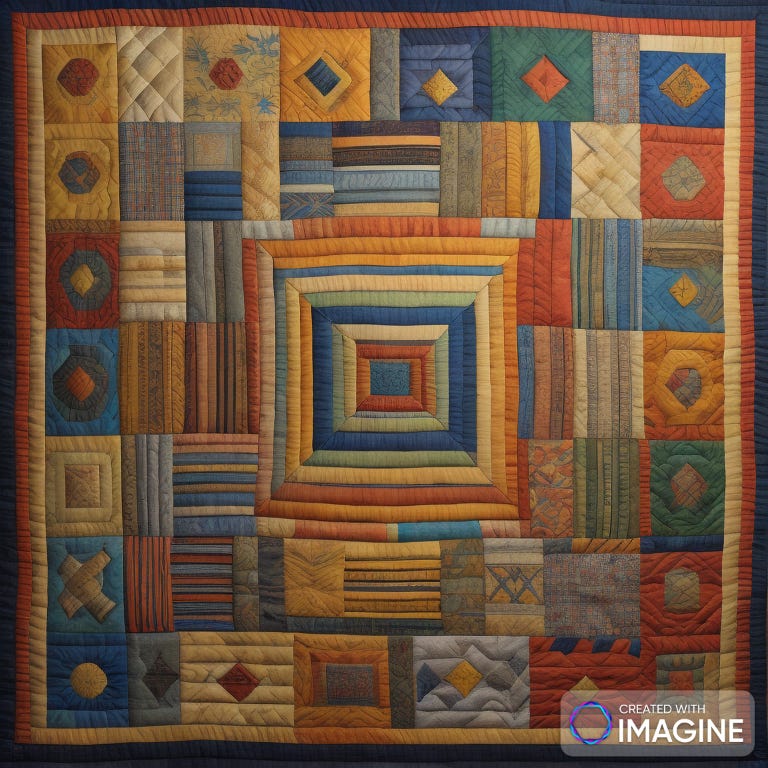the design of social media benefits the strongman
2024 can be the year that Indian and American societies, in tandem with the social media that shapes them, rebuild trust across differences and restore hope for democracy.
The political climate of India and the United States
In 2024 there will be over 80 national elections which involve an estimated 4.2 billion people—52 percent of the globe’s population. This is the largest election cycle the world will see until 2048. In addition to the U.S. presidential election, voters will go to the polls in India, Mexico, South Africa, Taiwan, the EU, and dozens of other countries. The parliamentary elections in India – the most populated country in the world – will be between April and May.
I was in high school and college during the Obama years, and in activist circles folks talked about the imminent backlash for electing a Black president. Little did I realize that, in response to Barack Obama, the Tea Party had already started the process of uniting and radicalizing the right. I was a senior in college when Donald Trump was elected. During his presidency I worked in a newsroom and watched our reporters cover a polarizing, untruthful Administration. What felt to be turbulent times were brought to a seeming end by President Joe Biden. Biden restored some calm by sending MAGA politics into hibernation. While his quest for national unity has largely fallen on deaf ears, unknown to him I feel like Americans are nearly ready for unification. People are tired of divisive politics. Perhaps the national appetite for a good fight was finally punctured by the ongoing Israel-Palestine conflict. While Trump has indeed reared his head, Americans seem mostly checked out. “I’ve made peace with whatever will happen”, said a friend. “Until recently, the biggest impact of misinformation was simply the crisis of institutional trust. But now, a part of society is so saturated that it has decided to stop consuming information..If you disconnect from current events, your vote is less informed. Also, to what extent do you feel mobilized?” explains Carme Colomina, a researcher in global politics and disinformation at the Barcelona Center of International Affairs. What’s at stake in 2024? American democracy, our participation in wars overseas and relationship with China, artificial intelligence, and climate change.
India, which remains largely unknown to the West, is more similar to America than you think. It is, after all, a multiethnic, multiracial, multi-religious democracy. It is far easier for Japan or Denmark to be a cohesive and harmonious society. It is a far greater feat for America or India to accomplish this because societal tolerance for diversity is, in my opinion, the greatest project of humanity. It is empathy, compassion, knowledge, and humility at scale. If both nations can succeed as free societies for all, regardless of race, religion, gender, or class, then we are indeed great nations.
India’s prime minister, Narendra Modi, is running for reelection with the Bharatiya Janata Party (BJP). While I was in India for a few weeks at the beginning of 2024 I had conversations with family and friends on the state of the nation. The views were divergent and varied from pessimism to optimism, but it was clear that identity politics, be it religious or caste, has become an inescapable part of Indian life. (An important note about doing any kind of research in India is that speaking with non-English speakers is critical, and even with English speakers, the more you are able to converse in Indian languages the better you will be able to grasp the emotions and sentiments of the Indian people.)
Besides conversational interviews I did some independent research on India’s 2024 elections and here’s what’s on the ticket: infrastructure, economic growth, Hindu-Muslim tensions, geopolitics with China, and the erosion of democracy (an issue which constitutes the free press, freedom of political dissent, and an independent judiciary system).
With great power comes great responsibility
Social media platforms such as Facebook, Twitter/X, Whatsapp, Instagram, Youtube, and Snapchat are key players in shaping American and Indian public opinion and play an active role in the integrity of democratic elections. How so?
Social media platforms serve as major channels for the dissemination of news.
They provide real-time updates to the public, which can shape the formation of opinion.
User-generated content can shape views.
Whatever goes viral can amplify certain topics and influence public discourse; this can create a real or false sense of urgency about an issue.
Influencers on these platforms can sway public opinion.
It is well-researched that social media platforms are echo chambers.
These platforms are places where the public has discourse and debate, where activists organize, and where political candidates communicate with voters.
Per my understanding, Meta, Snap, Twitter/X, and Google have made some efforts to combat misinformation and disinformation but not enough. So here is some free game:
Work together to develop a collaborative information verification system that works cross-platform;
Establish partnerships with fact-checking organizations, subject-matter experts, journalists, academics, and engaged citizens to form a community-based fact-checking system;
Develop a rigorous, standardized criteria for assessing the accuracy of political information and communicate these criteria to contributors;
Promote user education and digital literacy;
Create a robust feedback mechanism within their platforms to gather input from users;
Publish what they find in trends of misinformation and create best practices for navigating political content on social media;
Elections, misinformation, and our fragile social fabric
During elections, misinformation and propaganda spreads especially quickly and widely, and in the American and Indian context you have two campaigns that are systematically leveraging social media to do this.
The similarities between what is “at stake” in America and India are eerie, but not a coincidence, much like the eerie similarities between Trump and Modi. Both have a populist style of leadership and leverage social media to connect with their audiences directly or use social media to shape public discourse or make policy announcements. Both have positioned themselves as political outsiders who are not part of the traditional establishment and have created a cult of personality. Both use tactics of fear mongering and intimidation to get votes. In pluralistic democracies the dominant group still controls the narrative so both leaders have carved a path to power by exclusively appealing to the dominant group, whether it’s Trump appealing to white voters or Modi appealing to their Hindu counterparts.
Because the most divisive content receives the most engagement and dissemination, fear mongering has a particularly harmful effect on pluralistic societies. For older generations, this impact comes through Facebook or Whatsapp and for younger generations it comes through Instagram, Snapchat, or Twitter/X. This makes it all the more incumbent that these societies, both at the public and private level, address misinformation and disinformation on social media if they want to be cohesive and peaceful.
“In India, we see how polarization is fueled by the government itself. [Prime Minister] Narendra Modi deploys a very divisive speech. His supporters use disinformation campaigns to spread rumors, to criminalize the Muslim population,” says Colomina.
Safety by design
Meta, Twitter/X, and Google have implemented some, but not enough, changes in place to curb propaganda and fear-mongering. Meta’s has an ad transparency center and the Oversight board. Twitter/X has community notes, and Youtube has misinformation policies, but I was unable to find any product interventions they have tried.
These platforms need to shift at a more fundamental level if they are to solve the misinformation problem. For new platforms, such as Threads and Bluesky, here is an enormous opportunity to differentiate themselves:
Adopt a integrity design approach to product design which includes:
Misuse Prevention: Design core mechanics to discourage and prevent certain types of bad experiences.
Limits and Restrictions: Implement measures such as rate limits to deter systematic abuse of social tools.
Account transparency: Add context to accounts to make it difficult for inauthentic actors to hide abusive or misrepresentative behavior.
Safety controls: Offer safety controls to give users agency in controlling their online experiences, such as comment moderation tools.
Risk reduction: Implement contextual friction, informative treatments, and promoting positive community norms to reduce potential reach and intensity of integrity risks.
Effective and Fair Enforcement: Balance equities, respecting voice, due process, privacy, and accountability in the enforcement process.
Community Feedback: Leverage input from the community to increase the precision of content demotion and provide lightweight feedback mechanisms.
Education and Recourse: Ensure transparency, appeals, and meaningful pathways for users to influence policy formation and enforcement.
Use the design codes for social media, created by the USC Neely Center.
Use the inclusive product development playbook, created by the Wikimedia Foundation.
Employ strategies from trauma-informed design, where the voices and needs of users often excluded from major tech spaces are heard and considered in the decision-making processes about their online lives.
Insights from the Oversight Board on content moderation and political discourse
If you haven’t heard of the Oversight Board, it “was created to help Meta answer some of the most difficult questions around freedom of expression online: what to take down, what to leave up, and why.” The Oversight Board faces the challenge of balancing free speech and preventing harm, but it often appears to primarily hold Meta accountable to its own policies. Through a thorough review process, the board provides innovative practices for assessing each case, contributing to the ongoing learning in navigating the complexities of free speech versus hate speech in the digital realm.
“As the 2024 elections approach, social media platforms face the critical task of addressing the spread of fake news and the influence of artificial intelligence (AI) on democratic processes. Striking the right balance between combating misinformation and upholding freedom of expression becomes increasingly crucial…while the task of determining what content should be removed is not simple, the consequences of allowing misinformation to spread unchecked can undermine the integrity of elections.” — Oversight Board
The personal is political
I keep returning to Mahātmā Gandhi’s notion of “satyagraha”, a lifelong spiritual struggle for the truth. Gandhi believed that for India to be a successful post colonial nation it needed to be unified as one people. His profound achievement was one of the imagination; imagining the Indian people as one, regardless of caste, religion, or gender. American and Indian society are struggling to be a united people, and I feel it in my interactions with friends, family, colleagues, and strangers. 2024 can be the year that these societies, in tandem with the media that shapes them, rebuild trust across differences and restore hope for democracy.





